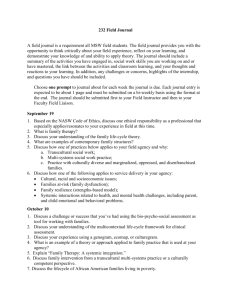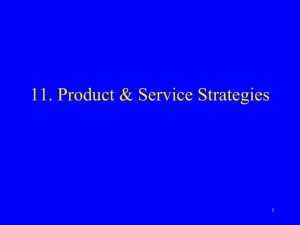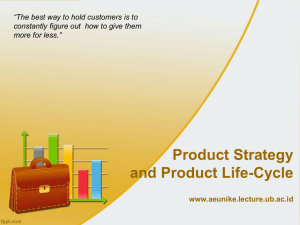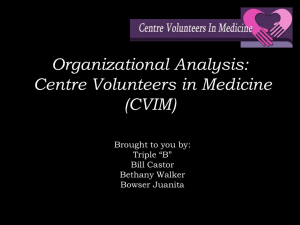Business models in project-based firms – Towards a typology of
advertisement
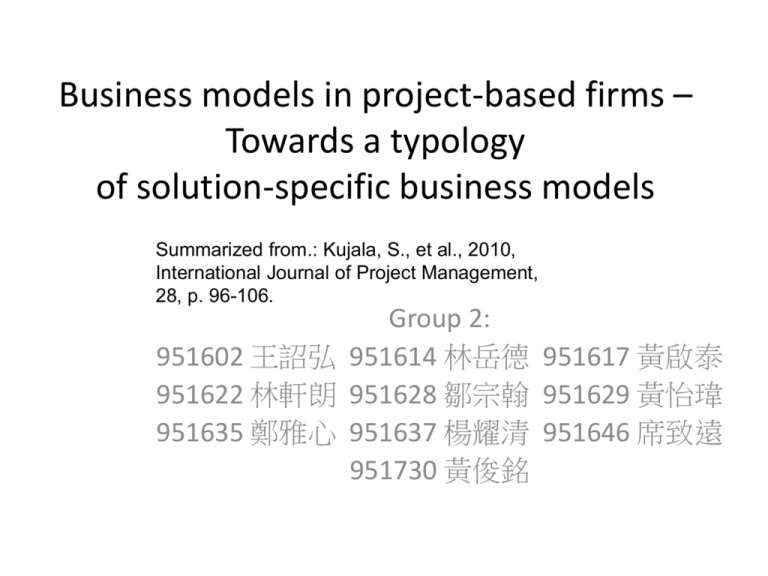
Business models in project-based firms – Towards a typology of solution-specific business models Summarized from.: Kujala, S., et al., 2010, International Journal of Project Management, 28, p. 96-106. Group 2: 951602 王詔弘 951614 林岳德 951617 黃啟泰 951622 林軒朗 951628 鄒宗翰 951629 黃怡瑋 951635 鄭雅心 951637 楊耀清 951646 席致遠 951730 黃俊銘 1.introduction 951614 林岳德 Introduction • A trend towards more servitized offerings and life-cycle solutions is leading to a fundamental change in business models in the capital goods businesses. • Exp: power plant business. 5 point of views in literature 1. de-regulation and outsourcing have led to the emergence of new types of customers. (Ivory and Thwaites, 2003) 2. Integrating high-value projects in a seamless solution with a long-term operations and maintenance (O&M) service requires a project supplier. (Helander and Mo‥ ller, 2007) 3. longterm business perspectives and a change of logic in earning, present challenges. (Brady and Davies, 2004; Hobday et al., 2005) 5 point of views in literature(cont.) 4. Servitization in the capital goods business pushes project suppliers to develop and to offer total solutions. (Wise and Baumgartner, 1999; Ivory and Thwaites, 2003) 5. By occupying a larger share and responsibility of the customers’ businesses, project suppliers are also given the possibility of capturing a larger portion of the overall value stream and to gain more profits. (Davies, 2004) General-level research question • What different types of business models have projectbased firms implemented and what are their key characteristics? • We divide this research question into three subquestions: 1. Is it possible to assess business models at the solutionlevel in a project-based firm? 2. What are the key elements of business models on the level of a firm and on the level of a single solution? 3. Is it possible to identify a typology of solution-specific business models and can such a typology be used for evaluating the business performance of solutions? Contents of subquestions 1. The first sub-question: • Seeks the existence of business models on the level of single solutions. • A firm can have more than one business model for different markets and customers. • We find it necessary to investigate whether the business models in project-based firms are specific to the delivery of each solution. Contents of subquestions(cont.) 2. The second and third sub-questions: • Address the content and typology of such solution-specific business models. • These subquestions facilitate a solution-level analysis of a project supplier firm’s business models. Answer • 1. 2. • • A solution offered by a project firm is defined as including both a project component and an after-sales service component. First, analyze the literature concerning business models and suggest six key elements of a firm-level business model. Then, construct a conceptual framework for the analysis of the business model characteristics of solution deliveries. The origins of the framework is built on the ideas and conceptual structures of installed-base-related solutions as introduced by Oliva and Kallenberg (2003). By instating a broader conceptual analysis and synthesis of service and solution literature, we construct a framework with four types of business models. Answer(cont.) 3. Then assess the key characteristics of the business models of five distinct solution deliveries within a power plant supplier firm through the use of an embedded case study. • The empirical study uses the structure of the six key elements for analyzing the business models in each of the five case solutions. • Based on the results of the empirical study, we conclude that the business models used in the five solutions are indeed different and specific to each of the studied solution. 4 important contributions 1. we suggestwe suggest six key elements for business models. 2. we develop a typology of five solution-specific business models and present the key characteristics for each business model type. 3. we show how the typology can be used to evaluate the performance of business models. 4. we find the solution-specific nature – or solution specificity – of a firm’s several business models. 2. The business model concept: different perspectives and key components 951622 林軒朗 Introduction • In general, the discussion of business models usually takes place on the firm-level(Siggelkow, 2001; Tikkanenet al., 2005; Hedman and Kalling, 2003) • The analysis of business models should not be restricted to a firm- or a business unit-level only (Slywotsky et al., 1998; Magretta, 2002; Chesbrough and Rosenbloom, 2002). • Slywotsky et al. (1998) encourage firms to more carefully design their businesses for their customers,and accordingly, to be innovative in how they employ profit models. Introduction that a firm can have several distinct business models. • Building on their arguments for business models that are designed at a more detailed level. • we analyze business models on a solution-level in order to propose a framework for analyzing business models that are specific for separate solution deliveries. • Magretta (2002) and Chesbrough and Rosenbloom (2002) suggest 2.1. Perspectives on business models • Although the concept of a business model is considered useful in management vocabulary (Tikkanen et al., 2005) • It is still a lack of consensus on what comprises a business model • • (Magretta, 2002; Hedman and Kalling, 2003; Tikkanen et al., 2005; Morris et al., 2005). • Business models build upon the theoretical traditions of business strategy in an effort to combine the different views on strategy and the relationship of a firm’s strategy and performance, especially in an effort to combine • 1.The perspectives of industrial organization (Porter) • 2.a resource-based view ( Peteraf, Wernerfelt) • 3.strategy process (Chakravarthy and Doz, Mintzberg) Difference in business model & business strategy • business models differ from business strategy in that • A business model assumes that a manager’s knowledge is cognitively limited (Chesbrough and Rosenbloom, March and Simon) • Cognitive limitations are significant and managerial action may be biased by the earlier success of the firm (Hedman and Kalling, Siggelkow, Tikkanen). • strategy emphasizes competition, business models build on creating value for the customer (Morris et al., 2005). a different perspective on business model From a different perspective, the term business model is often used for describing the underlying logic for a supplier’s revenue and profit generation (Slywotsky et al., 1998; Magretta, 2002; Morris et al., 2005). 2.2. The role of value creation and value capture in business models • A business model addresses both value creation for the customer(Vargo and Lusch,Ulaga,Normann) and value capture for the supplier (Walter et al.,Mo‥ ller and To‥rro‥nen, ). • Most conceptualizations of business models build on value creation for the customer (Chesbrough and Rosenbloom, 2002; Morris et al., 2005; Magretta, 2002). • Slywotsky et al. (1998) discuss business designs and profit models, which effectively describe a number of basic level economic models that firms can Innovatively employ and combine to create a profitable business. 2.3. Synthesis on the business model elements • • • • • • • six key elements of a business model : (1) customer (2) value proposition for the customer (3) competitive strategy (4) position in the value network (5) suppliers’ internal organization and its key capabilities (6) logic of revenue generation use these six key elements to analyze literature in order to • 1.characterize the different business models for solutions • 2.to create a conceptual framework of solution- specific business models . 3.use the six elements in the empirical analysis and develop a typology of solution-specific business models. 3. The effect of servitization on project suppliers’ business models 951629 黃怡瑋 • To construct the framework of solution-specific business models, we need to explore the following factors: (1)Solution of project-based firms combine project delivery. (2) Life-cycle-focused after-delivery service. • To describe the service orientation in traditional manufacturing businesses, we proposed “servitization “ servitization • Servitization is defined as a trend in manufacturing to offer for integrated bundles, or both solutions and operational services in the value stream. • Characteristic: (1)Combined goods, services, knowledge support and a customer’s self-service. (2)Customers’ purchasing decisions increasingly focus on the life-cycle costs of the system . (3)Long-term commitment. (4)Service-dominant logic. Holistic view towards businesses • Establish a successful relationship between enterprise and customer. • Focus on the utilization of products instead of traditional manufacturing activities and short-term transactions. • Emphasis on the solution ”servitization” : →A solution here includes a project component and a service component that either can be offered separately or as a whole (lifecycle focused integrated offering). 4. Conceptual framework for analyzing solution-specific business models 951602 王詔弘 951730 黃俊銘 What is a framework • Develop a framework for the analysis of a project supplier’s business models for delivering solutions. • Origins in the servitization model presented by Oliva and Kallenberg (2003) How to construct a framework Use two dimensions as a starting point • the value proposition for the customer • the revenue generation logic for the supplier How to construct a framework • We develop it to address the life-cycle view of solutions • by simultaneously including the six key elements of a business model . Four types of business model • • • • Basic installed base services Customer support services Operations and maintenance outsourcing Life-cycle solutions ↓ six key elements Life-cycle solution ← Construct a framework • According to Oliva and Kallenberg (2003) a firm’s revenue generation logic can either be based on providing transactional product services or on relationship-based services. • The other dimension of Fig. 1 displays the offering for either product-oriented or process-oriented services and implies a change in customer value proposition from product efficacy to product’s efficiency in the user’s process. Construct a framework • Taking over the end-users operations, requires the supplier to assume operational risk and to take the responsibility of the end-users process. • Gebauer (2008) develops the typology by Oliva and Kallenberg in his identification of service strategies for manufacturers. He finds that customers who outsource their operations to suppliers often have a strong interest in reducing their initial investment and therefore outsourcing-type of services are rather standardized and product-oriented. • Instead, providers of process-oriented customer support services and development services perform best with a service and product differentiation strategy as they operate in markets with less competition. SUMMARY • We adopt the following framework dimensions; value proposition for the customer, and pricing, or revenue generation logic, for the supplier from Oliva and Kallenberg(2003) for the conceptual framework on business models for solutions. • We emphasize the life-cycle view of solutions in order to create long-term value for both the customer and the supplier . 5. Research method and the case company 951637 楊耀清 Research Method • In order to assess potential differences in solution-level business models and their characteristics, we collected empirical data following a single embedded unit case study method (Yin, 1990). • Embedded unit case study design was considered to be appropriate for an in-depth understanding of the detailed characteristics and of the potential differences in various business models that a firm uses in its solution deliveries. Embedded case study • An embedded case study is a case study containing more than one sub-unit of analysis (Yin, 2003). Similar to a case study, an embedded case study methodology provides a means of integrating quantitative and qualitative methods into a single research study (Scholz & Tietje, 2002; Yin 2003). Case Company • The firm under analysis is Consolidated Power Company (CPC, a pseudonym), a multinational power company with annual sales of around 4000 million Euros. • CPC is a multi-business company but this research focuses on its power plant supplier business. The supplier’s power installation projects are flexible, ranging from simple equipment deliveries to fullscale turn-key deliveries. Operations and Maintenance (O&M) • In operations and maintenance (O&M) services, the O&M unit can manage all aspects of the operation and maintenance of a power installation. The scope of the O&M contract is tailored according to a customer’s needs. Engineer, Procure, Construct (EPC) • The components of the five solutions that we analyze all include an engineer, procure, construct (EPC) – project delivery followed by a long-term O&M service contract . • Such project and service components are analogous to the ‘‘systems integration” and ‘‘operational services” stages in the value stream of integrated solutions proposed by Davies (2004). Key information on the five solutions Project – led solution • Project – led solution: In four of the solutions, the customer was first offered and sold a power plant project that was based on the customer’s specifications in the EPC project tender. In these four solutions, the O&M contract was offered separately after the EPC project was offered . Life – cycle – led solution • Life – cycle – led solution: The fifth solution in the sample was a solution with a seamless offering for the customer, consisting of an integrated EPC project and O&M service. The interviews 6. Analysis of the business models of the five solutions 951617 黃啟泰 Analysis of the business models of the five solutions • we describe the results of the analysis on the business models of the five solutions. We used the data to identify and analyze in detail the contents of the six key business model elements of each of the five solutions. six key elements of the business models in the five solutions • The synthesis of the distinctive business model characteristics in each of the five case solutions based on the analysis, is provided in Table 4. • Table 4 distinguishes between different customer segments, and it compares the six key elements of the business models in the five solutions. The last row of Table 4 indicates the business model type for each of the solutions. Delivery of life-cycle solutions and Development of life-cycle solutions • Based on the results of the analysis, we refined the original conceptual framework by dividing business model 4 (Lifecycle solutions) into two separate business models; • 4a:‘‘Delivery of life-cycle solutions” and 4b: ‘‘Development of life-cycle solutions”, (see Fig. 3) that are both included in type 4 (‘‘Life-cycle solutions”) (see Fig. 3). difference between these two business model types • The main difference between these two business model types is the supplier’s revenue generation logic: the Development solution had more upfront costs and required more extensive business, market and stakeholder management capabilities Delivery of life-cycle solutions and Development of life-cycle solutions • The Development of life-cycle solutions business model employs an organizational model that is led by a separate customer-facing team • By contrast, in the business model for the Delivery of life-cycle solution the design of the solution was instead handled by a proactive marketing department that promotes the lifecycle aspect of the solution while the actual delivery was organized by separate project and service units a typology of the five types of business models • Based on these considerations, the four-type conceptual framework is expanded to a typology of the five types of business models(Fig. 3). 7. Performance of the solutions 951635 鄭雅心 Performance of the solutions We concluded five solutions, • under- performing ─ the solutions that used operations and maintenance outsourcing-business model. (Co-Generation、Base Load、Metal Industry solutions) • high- performing ─ the solutions that used Delivery or Development of life-cycle solutions business model. (Development 、 Construction Industry solutions) under-performing • Base Load & Co-Generation solutions ─ the customers were sold only what they had asked for, without careful consideration for the implications for the customer’s or for CPC’s own value-creation processes. → This resulted in a poor external fit of business model elements and offering of solutions that did not fit the customer’s strategy. Desirable shift • It provided both the customer and the supplier with a better overall performance in terms of life-cycle service cost, revenue and quality. high-performing • Construction & Development solutions ─ Construction and the Development solutions managed to proactively anticipate the customer’s need. → These solutions seem to be more successful because they concentrated the value proposition to the customer’s process and could define an appropriate scope for the life-cycle solution. conclusion • The contrast between high-performing and underperforming solutions indicates that : → a supplier sometimes needs to go beyond the customer’s expressed needs in order to find the best solution for the customer and also to guarantee itself the best performance from the solution. 8.Conclusion 951628 鄒宗翰 Business Model • This paper focused on analyzing business models used for delivering solutions. • Project suppliers do in fact employ a number of different solution-specific business models • Typical business within the case firm is comprised of unique solution deliveries. Business Model (Conti.) • six business model elements ->business models for the five solutions • Based on the empirical study, refined the framework to a typology of five solution-specific business models. • The business models in project-based firms should be analyzed at the level of individual solutions Successful Solution • The most successful solution deliveries seem to focus on enhancing the solution’s performance in the customer’s own value creation process • The choice of the business model for the solution delivery must be adapted to the customer’s strategy Problem • The disintegration of the project • The service delivery units • The reactive marketing led to product-centric value propositions that hindered the efficient solution delivery and decreased the case firm’s ability for value creation both for itself and for the customer CONCLUSION • More careful consideration of the customer’s strategy and long-term business needs • The supplier’s own revenue generation logic and internal capabilities could have resulted in a more cost-efficient and high-quality life-cycle 9. Discussion and further research 951646 席致遠 Discussion • six key elements of a solution-specific business model • five business model types are: – The basic installed base services – The customer support services – The operations and maintenance outsourcing – The delivery of life-cycle solutions – The development of life-cycle solutions Discussion(cont.) • Looked at project development from a business perspective. • Provides evidence of how concentrating the solution’s value proposition on its use-phase. – Align the supplier’s and the customer’s interests – supplier gain higher profits. – Enhance the customer’s own business performance. Further research • Is the suggested typology of solution-specific business models valid in other project-based firms or industries? • Are there interactions and coexistence of the solution-level and the firm-level business models in project-based firms? • What are the contextual factors or the drivers and barriers that affect the choice of the business model in a projectbased firm? • What are the factors that affect a delivered solution’s performance during its life-cycle?
